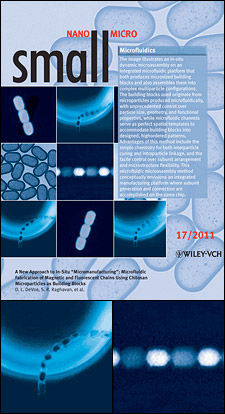News Story
Raghavan, DeVoe Introduce New Micromanufacturing Approach in Small

Top: Raghavan and DeVoe's novel approach to lab-on-a-chip manufacturing was illustrated in the frontispiece of Vol 7, Issue 17 of Small, a leading interdisciplinary journal covering micro- and nanotechnology. Lower left: A flexible chain of chitosan microbeads containing magnetic particles, produced by the team's lab-on-a-chip, arches under the influence of a magnetic field. Lower right: Another chitosan chain manufactured by the chip shows an alternating pattern of light (fluorescing) and dark (magnetic particle-filled) microbeads.
Department of Chemical and Biomolecular Engineering (ChBE) Associate Professor Srinivasa Raghavan and Department of Mechanical Engineering (ME) and ChBE affiliate Professor Don DeVoe, along with their advisee, Ph.D. student Kunqiang Jiang (Department of Chemistry and Biochemistry), led the project team, which also included ChBE graduate students Chanda Arya and Elijah George, ME graduate student Chenren Shao, and Chao Xue, a visiting undergraduate from the Massachusetts Institute of Technology.
Lab-on-a-chip technology, which is DeVoe’s area of expertise, is used to mix, separate, analyze, and conduct reactions between fluids in a device approximately the size of a postage stamp and not much thicker than a microscope slide. These tiny tools have applications in drug testing and discovery, sensor design, medical diagnostics, and threat detection, and have the potential to make more technology portable and accessible in situations that would otherwise require a laboratory or expensive equipment.
More recently, researchers have adapted lab-on-a-chip technology to create microfactories: materials are flowed in, chemical reactions occur, and a new product comes out. In the present case, the team collaborated to create microscale beads out of a natural bipolymer called chitosan, which had been studied previously in Raghavan’s lab.
"Normally the focus is merely on making such beads, which I think of as building blocks, in a very regular way," says Raghavan. "But we are taking it a step further. What we're doing is manufacturing the building blocks and further assembling them into higher order structures on the same chip. That is an important concept, and to our knowledge we are the first to demonstrate it."
While Raghavan describes his chips as factories that input mere nanoliters of ingredients through their microfluidic channels at one end and turn out "assemblies” at the other, he feels the product they produce, is not as important as how.
"I think the overall concept is far more important," he explains. "It's a platform for the development of so much more."
He cites the creation of targeted drug delivery systems as one example of what could be accomplished with this new, more advanced form of micromanufacturing.
A targeted drug delivery device, for example, is usually comprised of several components that must all work together: a guidance system, a means to chemically lock onto its target once in position, a therapeutic agent and the means to carry and deliver it, and sometimes an imaging agent so its effectiveness can be monitored.
"Typically," says Raghavan, "you have to add all these components sequentially. It requires a complicated series of chemical reactions and purifications to assemble a final product, which may not actually work. You might have to create and combine everything again and again in different proportions to get the qualities and functionality you need. Suppose instead you could make individual building blocks with discrete functionalities and snap them together in different configurations, one after the other, until you find what you're looking for. Our lab-on-a-chip approach can provide that level of flexibility."
To demonstrate the exact level of control over assembly and final output, which can be achieved by precisely altering the flow rates of the fluids entering their chips, the team created chains of chitosan microbeads with very specific qualities. In the paper, they describe how they were able to manufacture light beads that fluoresced and dark beads containing magnetic nanoparticles, connect the beads into chains of different lengths, control the ordering or patterning of lights and darks in a chain's sequence, control the chain's overall flexibility, and cause lengths of chain to whip back and forth using a magnetic field.
"Right now it's a proof of concept," says Raghavan, "but we're very excited. What we're trying to say in the paper is, just think about what you could do with this level of control."
For More Information:
See Kunqiang Jiang, Chao Xue, Chanda Arya, Chenren Shao, Elijah O. George, Don L. DeVoe, and Srinivasa R. Raghavan. A New Approach to In-Situ "Micromanufacturing": Microfluidic Fabrication of Magnetic and Fluorescent Chains Using Chitosan Microparticles as Building Blocks. Small, 7, 17 2470–2476 (2011). Read the abstract online »
Visit the Complex Fluids and Nanomaterials Group web site »
Visit the MEMS and Microfluidics Laboratory web site »
Published November 3, 2011









